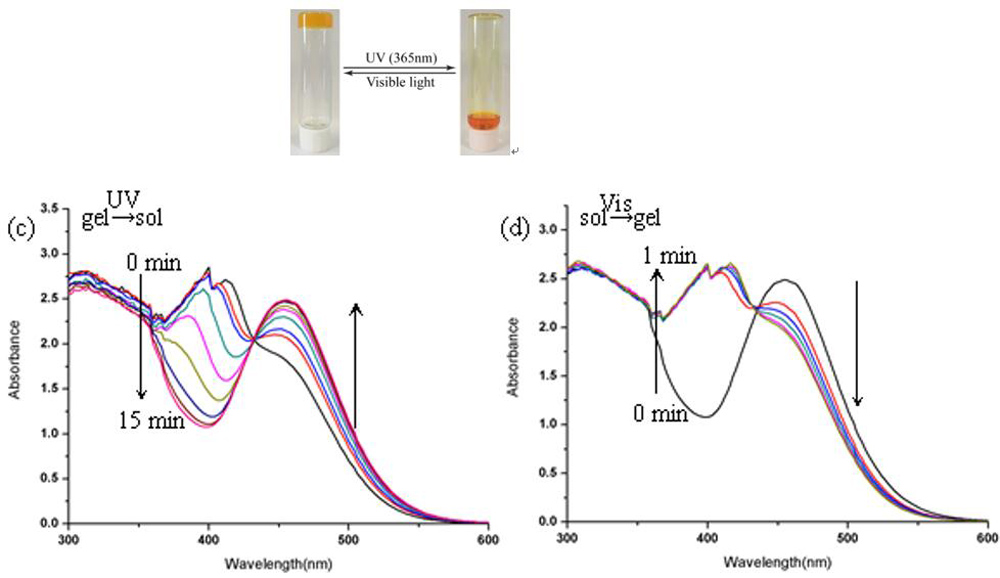

Frontiers of Chemical Science and Engineering >
Synthesis and properties of novel organogelators functionalized with 5-iodo-1,2,3-triazole and azobenzene groups
Received date: 22 Apr 2016
Accepted date: 12 Jun 2016
Published date: 29 Nov 2016
Copyright
Two series of 5-iodo-1,2,3-triazole derivatives containing azobenzene group(s) were synthesized and their gelling properties were tested. Those containing two azobenzene groups (B series) have better gelation performance than those containing one azobenzene group (A series). The microstructure of organogels and the driving force of gelation were investigated by scanning electron microscopy and 1H NMR, respectively. It was found that π-π stacking, van der Waals interaction, and dipole-dipole interaction were the main forces of gelation. All the tested organogels are photoresponsive and those from B series are smarter than that from A series. Henry δp-δh diagrams of compounds A1, A2, and B2 were constructed on the basis of their gelation performance and the Hansen solubility parameters of related solvents. The constructed Henry δp-δh diagrams can be used to estimate the behavior of three compounds in any untested solvent.

Ziyan Li , Yaodong Huang , Dongli Fan , Huimin Li , Shuxue Liu , Luyuan Wang . Synthesis and properties of novel organogelators functionalized with 5-iodo-1,2,3-triazole and azobenzene groups[J]. Frontiers of Chemical Science and Engineering, 2016 , 10(4) : 552 -561 . DOI: 10.1007/s11705-016-1589-8
| 1 |
Gawlitza K, Wu C, Georgieva R, Wang D, Ansorge-Schumacher M B, von Klitzing R. Immobilization of lipase B within micron-sized poly-N-isopropylacrylamide hydrogel particles by solvent. Physical Chemistry Chemical Physics, 2012, 14(27): 9594–9600
|
| 2 |
Jiang H L, Zhu Y H, Chen C, Shen J H, Bao H, Peng L M, Yang X L, Li C Z, New J. Photonic crystal pH and metalcation. New Journal of Chemistry, 2012, 36(4): 1051–1056
|
| 3 |
Sugiyasu K, Fujita N, Shinkai S. Photochemical processes visible-light-harvesting organogel composed of cholesterol-based perylene derivatives. Angewandte Chemie International Edition, 2004, 43(10): 1229–1233
|
| 4 |
Vintiloiu A, Leroux J C. Organogels and their use in drug delivery—A review. Journal of Controlled Release, 2008, 125(3): 179–192
|
| 5 |
Sagiri S S, Singh V K, Banerjee I, Pramanik K, Basak P, Pal K. Core-shell-type organogel-alginate hybrid microparticles: A controlled delivery vehicle. Chemical Engineering Journal, 2015, 264: 134–145
|
| 6 |
Kubo W, Murakoshi K, Kitamura T, Yoshida S, Haruki M, Hanabusa K, Shirai H, Wada Y, Yanagida S. Quasi-solid-state dye-sensitized TiO2 solar cells: Effective charge transport in mesoporous space filled with gel electrolytes containing iodide and iodine. Journal of Physical Chemistry B, 2001, 105(51): 12809–12815
|
| 7 |
Hirst A R, Smith D K. Solvent effects on supramolecular gel-phase materials: Two-component dendritic gel. Langmuir, 2004, 20(25): 10851–10857
|
| 8 |
Bielejewski M, Lapiński A, Luboradzki R, Tritt-Goc J. Solvent effect on 1,2-O-(1-ethylpropylidene) -alpha-D-glucofuranose organogel properties. Langmuir, 2009, 25(14): 8274–8279
|
| 9 |
Zhu G Y, Jonathan S D. Solvent effect on organogel formation by low molecular weight molecules. Chemistry of Materials, 2006, 18(25): 5988–5995
|
| 10 |
Lindvig T, Michelsen M L, Kontogeorgis G M. A Flory-Huggins model based on the Hansen solubility parameters. Fluid Phase Equilibria, 2002, 203(1-2): 247–260
|
| 11 |
Lan Y, Corradini M G, Liu X, May T E, Borondics F, Weiss R G, Rogers M A. Comparing and correlating solubility parameters governing the self-assembly of molecular gels using 1,3:2,4- dibenzylidene sorbitol as the gelator. Langmuir, 2014, 30(47): 14128–14142
|
| 12 |
Huang Y D, Yuan Y Q, Tu W, Zhang Y, Zhang M J, Qu H M. Preparation of efficient organogelators based on pyrazine-2,5-dicarboxylic acid showing room temperature mesophase. Tetrahedron, 2015, 71(21): 3221–3230
|
| 13 |
Bhalla V, Gupta A, Kumar M, Rao D S S, Prasad S K. Self-assembled pentacenequinone derivative for trace detection of picric acid. ACS Applied Materials & Interfaces, 2013, 5 (3): 672–679
|
| 13b |
Dong S, Zheng B, Wang F, Huang F. Supramolecular polymers constructed from macrocycle-based host-guest molecular recognition motifs. Accounts of Chemical Research, 2014, 47: 1982–1994
|
| 13c |
Doran S, Yilmaz G, Yagci Y. Tandem photoinduced cationic polymerization and CuAAC for macromolecular synthesis. Macromolecules, 2015, 48: 7446–7452
|
| 14 |
Huang Y D, Zhang Y, Yuan Y Y, Cao W W. Organogelators based on iodo 1,2,3-triazole functionalized with coumarin: Properties and gelator-solvent interaction. Tetrahedron, 2015, 71(14): 2124–2133
|
| 15 |
Beharry A A, Woolley G A. Azobenzene <?Pub Caret?>photoswitches for biomolecules. Chemical Society Reviews, 2011, 40(8): 4422–4437
|
| 16 |
Pei X W, Fernandes A, Mathy B, Laloyaux X, Nysten B, Riant O, Jonas A M. Correlation between the structure and wettability of photoswitchable hydrophilic azobenzene monolayers on silicon. Langmuir, 2011, 27(15): 9403–9412
|
| 17 |
Petr M, Hammond P T. Room temperature rapid photoresponsive azobenzene side chain liquid crystal polymer. Macromolecules, 2011, 44(22): 8880–8885
|
| 18 |
Yuan T, Dong J, Han G, Wang G. Polymer nanoparticles self-assembled from photo-, pH- and thermo-responsive azobenzene functionalized PDMAEMA. RSC Advances, 2016, 6(13): 10904–10911
|
| 19 |
Matthieu R, Laurent B. Organogel formation rationalized by Hansen solubility parameters. Chemical Communications, 2011, 47(29): 8271–8273
|
| 20 |
Hansen C M. Hansen Solubility Parameters: A User’s Handbook, 2nd ed. Boca Raton: CRC Press, 2007
|
| 21 |
Fan D L, Zhai Y, Zhang Y, Tu W, Huang Y D. Synthesis and properties of photoresponsive organogels based on azobenzene derivatives. Chemical Journal of Chinese Universities, 2014, 35(11): 2447–2454
|
| 22 |
Liu Z X, Feng, Yan Z C, He Y M, Lui C Y, Fan Q H. Multistimuli responsive dendritic organogels based on azobenzene-containing poly(aryl ether) dendron. Chemistry of Materials, 2012, 24(19): 3751–3757
|
/
| 〈 |
|
〉 |